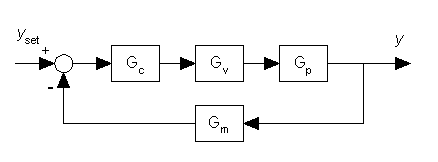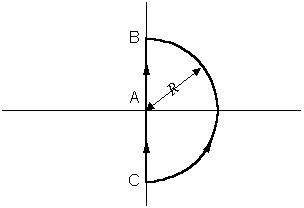NYQUIST STABILITY CRITERION
I. Setup and Assumptions:
Feedback System:

Figure 1.
Closed Loop Transfer Function:

Characteristic Equation:
1 + GcGvGpGm=0
(Note: This equation is not a polynomial but a ratio of polynomials)
Stability Condition: None of the zeros of ( 1 + GcGvGpGm
)are
in the right half plane.
Assumption: Gc, Gv, Gp and Gm
are all stable, i.e. stable (open-loop) process, controller, actuator and
sensor. This means (1 + GcGvGpGm
)
has no poles in the right half plane.
II. Objective : to determine the stability of a feedback
control system using frequency response data.
III. Preliminaries:
a) A transfer function G(s) is said to be proper if

and strictly proper if

(Note: All physically realizable systems are either proper
or strictly proper.)
b) If G(s) is a ratio of polynomial functions, then
-
G(s) is proper if the order of the numerator polynomial is less than or
equal than the order of the denominator polynomial
-
G(s) is strictly proper if the order of the numerator polynomial is less
than the order of the denominator polynomial
c) Nyquist path:
In the s-plane, the clockwise path A-B-C-A is a simple closed
semi-circle contour in the right half of the complex plane as shown below:

Figure 2.
As R approaches infinity, the contour will encompass all the
points in the right half plane.
d) Complex mapping using the Nyquist path:
Let G(s) be proper, then
- The mapping of G(s) along the path A-B is just G(iw)
for w=0 to R. This information is obtained from
frequency response experiments.
- The mapping of G(s) along the path B-C is just a finite constant
as R approaches infinity.
- The mapping of G(s) along the path C-A is G(-iw)
with w= - R to 0, i.e. the mirror image of G(iw).
IV. Nyquist Stability Criterion:
Assume Gc, Gv, Gp and Gm
are all stable. If the Nyquist plot of GcGvGpGm
(s) does not encircle the point -1+0i in the complex plane in the
clockwise direction, then the system is asymptotically stable.
Proof: According to the complex mapping theorem, the map
of (1+GcGvGpGm) along the Nyquist
path will encircle the origin N times, where N=Z-P. Since Gc,
Gv, Gp and Gm are all stable, P=0. Thus
N=Z. This means the number of encirclements of the origin indicates the
number of roots of the characteristic equation in the right half plane.
Thus for stability, we must have N=Z=0.
Finally, the map of GcGvGpGm
(s) is the map of 1+ GcGvGpGm
(s) shifted one unit to the left.
Click here for
sample applications of the stabilty criterion
This page is maintained by Tomas B. Co (tbco@mtu.edu).
Last revised 2/9/1999.
Tomas B. Co
Associate Professor
Department of Chemical Engineering
Michigan Technological University
1400 Townsend Avenue
Houghton, MI 49931-1295
Back to Homepage


